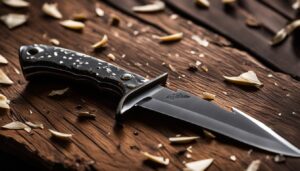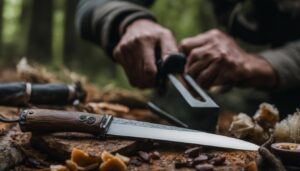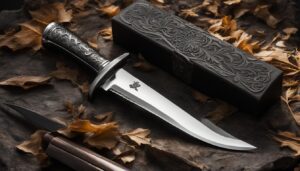As a custom knifemaker, I often get asked about knife sharpening. Many people struggle with maintaining a sharp edge on their hunting knives. However, sharpening a knife is not as complicated as it may seem. The key is to understand the goal of sharpening, which is to reduce the thickness of the leading edge to create a fine enough edge to cut effectively. This can be achieved by wearing away steel on an abrasive compound, such as an oil or diamond stone. It’s important to note that sharpening will raise a burr on the blade, indicating that you’re moving in the right direction.
Key Takeaways:
- Retain the edge on your hunting knife by understanding the goal of sharpening.
- Reduce the thickness of the leading edge to create a fine enough edge for effective cutting.
- Utilize abrasive compounds like oil or diamond stones to wear away steel.
- Sharpening will raise a burr on the blade, indicating progress.
Understanding Edge Geometry: The Key to Sharp Hunting Knives
When it comes to sharpening hunting knives, understanding edge geometry is crucial for achieving optimal cutting performance. The shape and bevel of the knife’s edge play a critical role in its cutting efficiency. Unlike a delicate straight razor used for shaving, a hunting knife needs to have more strength and durability.
Edge geometry refers to the shape and taper of the blade. A hunting knife with a consistent wedge shape that tapers to a fine edge at the business end will cut efficiently. However, many production knives have a secondary bevel interrupting the taper, which can lead to sub-optimal cutting performance. It’s important to consider the edge bevel and blade taper to maintain a sharp hunting knife.
“The cutting abilities of a hunting knife are determined by its edge geometry.”
By focusing on edge geometry, hunters can ensure that their knives are sharp and effective when it matters most. Understanding the relationship between edge bevel, blade taper, and cutting efficiency is key to maintaining a sharp hunting knife that can handle the rigors of the hunt.
https://www.youtube.com/watch?v=g__D5VuGGxE
Hunting Knife Edge Geometry
| Aspect | Description |
|---|---|
| Edge Bevel | The angle and shape of the edge that tapers to the cutting edge. |
| Blade Taper | The gradual reduction in thickness from the spine of the blade to the cutting edge. |
| Cutting Efficiency | The knife’s ability to cut through different materials effectively. |
Sharpening Techniques: How to Keep Your Hunting Knife Sharp at Home
Knife sharpening is a vital skill for any hunter looking to maintain the cutting edge on their hunting knife. By utilizing the right techniques and tools, you can ensure that your knife remains sharp and ready for use. One popular method of sharpening at home is using sharpening stones, which come in various grits to suit your needs.
To begin, start with a coarse grit stone to remove any nicks or damage from the blade. Hold the knife at a 20-degree angle and apply light pressure as you slide the blade across the stone in a sweeping motion. Repeat this process on both sides of the blade until a burr is formed. A burr is a small metal lip that forms at the edge of the blade, indicating that you have successfully removed enough material to create a sharp edge.
Once the burr is formed, switch to a finer grit stone to refine the edge further. Repeat the same process of sliding the blade across the stone at a 20-degree angle, this time applying slightly more pressure. This will help to polish the edge and remove any remaining burr. Remember to work on both sides of the blade evenly to ensure a balanced edge.
“Proper sharpening techniques are essential for maintaining the optimal cutting performance of your hunting knife.”
After using the sharpening stones, it is essential to remove any remaining burr and give the knife a final polish. This can be done by gently drawing the blade through a piece of timber or using a leather strop loaded with polishing compound. Both methods help to remove any residual burr and refine the edge to its maximum sharpness.
| Sharpening Material | Grain | Use |
|---|---|---|
| Coarse Grit Stone | 400-800 | Initial Edge Refinement |
| Fine Grit Stone | 1000-3000 | Polishing and Burr Removal |
| Leather Strop | N/A | Final Polishing |
With these sharpening techniques and tools at your disposal, you can keep your hunting knife sharp and ready for any task that comes your way. Proper maintenance and regular sharpening will ensure that your knife remains durable and reliable throughout your hunting adventures.

Field Sharpening: Quick and Effective Methods for Sharp Hunting Knives on the Go
When you’re out in the field, it’s crucial to have a quick and effective method for maintaining the sharpness of your hunting knife. Portable sharpeners with tungsten and ceramic slots are commonly used in such situations. These sharpeners are compact and lightweight, making them easy to carry in your hunting gear. The tungsten slot is used to remove some steel from the blade, while the ceramic slot is used to remove the burr. This two-step process allows you to quickly touch up the edge of your knife without the need for extensive sharpening.
Another method that works well for field sharpening is using wet and dry sandpaper attached to a flat surface. This method is similar to using a stone or a strop. To sharpen your knife, you simply run the blade against the sandpaper, following the cutting edge’s curve. The abrasive surface of the sandpaper effectively removes material from the blade, creating a sharp edge. This technique is particularly useful when you don’t have access to a portable sharpener or traditional sharpening stones.
In addition to portable sharpeners and sandpaper, you can also perform a quick touch-up on your hunting knife’s edge using a leather strap or strop. A leather touch-up helps refine the edge and remove any remaining burrs. Simply draw the blade across the leather surface, applying light pressure to polish the edge. This method is convenient and can be done on the go, ensuring that your hunting knife remains sharp and ready for use.
| Field Sharpening Methods | Pros | Cons |
|---|---|---|
| Portable sharpeners with tungsten and ceramic slots | – Easy to carry – Quick and efficient |
– May remove more material than necessary |
| Wet and dry sandpaper on a flat surface | – Lightweight and portable – Can be used without additional tools |
– Requires a flat surface – Can be time-consuming |
| Leather touch-up | – Convenient and portable – Polishes and refines the edge |
– May not be suitable for heavily damaged blades |
Tips for Knife Maintenance: Keeping Your Hunting Knife Sharp and Durable
In addition to sharpening your hunting knife, proper maintenance is crucial for ensuring its longevity. By following these tips for knife maintenance, you can keep your hunting knife sharp and durable for many seasons to come.
Blade Care
One of the most important aspects of knife maintenance is taking care of the blade. After each use, make sure to wash the blade with warm water and mild soap to remove any dirt, debris, or residue. Avoid using harsh chemicals or abrasive materials that could damage the blade. Once clean, dry the blade thoroughly with a soft cloth to prevent any moisture from causing rust or corrosion.
Washing and Oiling
After cleaning, it’s essential to apply a thin layer of oil to the blade to protect it from rusting. Use a high-quality knife oil or mineral oil and apply a small amount to a soft cloth. Gently rub the oil onto the entire blade, paying special attention to the cutting edge. This will create a barrier against moisture and prevent oxidation.
Sheath Usage
When your hunting knife is not in use, it’s important to store it in a sheath. A sheath not only protects the blade from accidental damage but also helps to maintain its sharpness by preventing contact with abrasive surfaces. Make sure the sheath is clean and dry before inserting the knife. Avoid storing the knife in a sheath that is too tight, as this can cause the blade to become dull over time.
Dexterity in Butchery
Lastly, developing dexterity in butchery techniques can significantly contribute to the longevity of your hunting knife’s sharpness. Practicing proper cutting techniques, such as using the appropriate blade angle and avoiding excessive force, can help minimize wear and tear on the edge. Additionally, learning how to properly debone and process game can help prevent unnecessary strain on the knife, ensuring it remains sharp and efficient for future hunts.
By following these tips for knife maintenance, you can keep your hunting knife in optimal condition and enjoy its sharpness and durability for years to come.
| Tip | Description |
|---|---|
| Blade Care | Wash the blade with warm water and mild soap after each use to remove dirt and debris. |
| Washing and Oiling | Apply a thin layer of oil to the blade to protect against rust and corrosion. |
| Sheath Usage | Store the knife in a sheath when not in use to protect the blade and maintain sharpness. |
| Dexterity in Butchery | Practice proper cutting techniques to minimize wear and tear on the knife’s edge. |
Conclusion
In conclusion, maintaining the cutting edge on your hunting knife requires practice and understanding. By following proper sharpening techniques and implementing effective maintenance practices, you can ensure that your hunting knife stays sharp for longer periods.
Long-lasting sharpness is achieved by regularly sharpening the blade, removing the burr, and maintaining the correct edge geometry. It’s important to remember that sharpening a knife is a skill that takes time to develop, so sharpening skills practice is crucial for achieving the desired results.
With dedication and knowledge, you can master the art of maintaining the cutting edge on your hunting knife. By prioritizing the proper sharpening and maintenance of your knife, you can enjoy optimal performance and durability during your hunting adventures.
FAQ
How often should I sharpen my hunting knife?
The frequency of sharpening depends on how often you use your knife and the tasks you perform with it. As a general guideline, it’s a good idea to touch up the edge of your hunting knife after each use and perform a more thorough sharpening session every few months.
What is the best method for sharpening a hunting knife at home?
There are several effective methods for sharpening a hunting knife at home. One popular technique is using sharpening stones, such as a combination oilstone with coarse and fine sides. Another option is using a guided sharpening system that helps maintain consistent angles. Experiment with different methods to find the one that works best for you.
How do I know when my hunting knife is sharp enough?
One way to test the sharpness of your hunting knife is by performing a paper test. If the blade slices through paper with minimal resistance and creates a clean, smooth cut, it is likely sharp enough for hunting tasks. Remember that different tasks may require different levels of sharpness, so adjust accordingly.
Can I use a honing rod to sharpen my hunting knife?
While a honing rod can help realign the edge of a knife and temporarily improve its cutting performance, it is not designed for sharpening a dull blade. To effectively sharpen your hunting knife, consider using sharpening stones or other specialized sharpening tools.
How can I prevent my hunting knife from becoming dull quickly?
Proper knife maintenance is essential for retaining the sharpness of your hunting knife for longer. Avoid cutting hard materials that can quickly dull the edge, clean and oil the blade after each use to prevent corrosion, and store the knife in its sheath or a protective case when not in use to protect it from abrasive surfaces.





